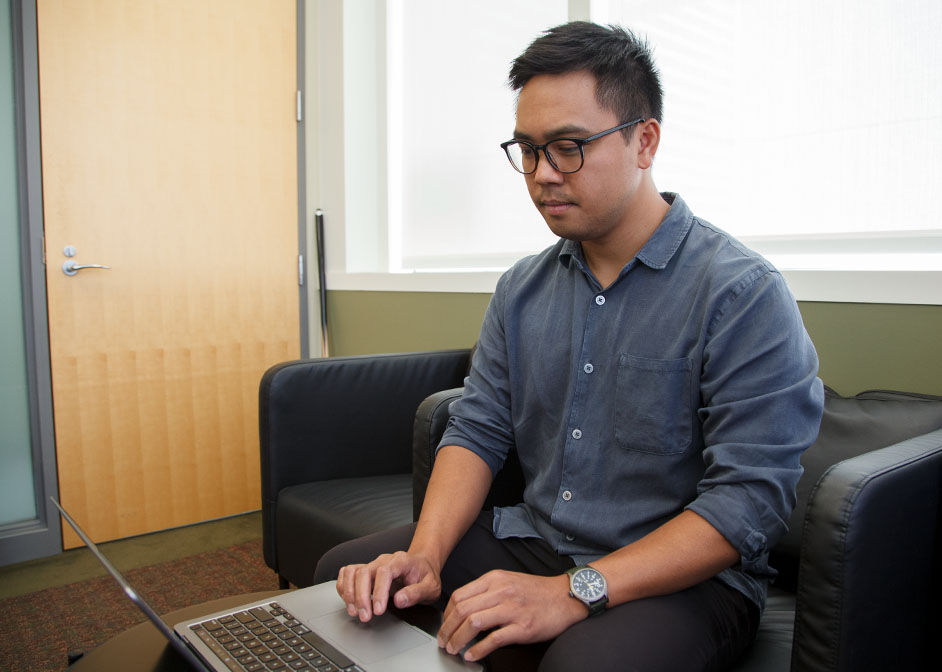Program Connects Early-Career Scientists to Global Peers, Industry Thought Leaders and Leadership Training
When it comes to research, Croix Laconsay has experience that spans international borders. Now, he has a unique opportunity to join an elite group recognized for science leadership potential.

Laconsay was chosen for the 2023 American Chemical Society’s CAS Future Leaders Program. CAS, a division of the American Chemical Society (ACS), identifies, aggregates, and organizes all publicly disclosed chemistry information.
The postdoctoral associate, in the Department of Chemistry at the UH College of Natural Sciences and Mathematics, is one of only 35 researchers around the world to earn a spot in the coveted program.
The 2023 class is made up of Ph.D. students and postdoctoral scholars chosen from hundreds of applicants with a variety of scientific backgrounds. The program focuses on early-career scientists and developing their leadership skills.
The selection committee considered Laconsay’s research in organic photochemistry with Judy Wu, UH associate professor of chemistry, and the Wu Research Group. His research in mechanistic organic chemistry while pursuing his Ph.D. with professor Dean Tantillo at the University of California, Davis, also played a role.
Digging Deeper into Chemical Reactions
At UH, Laconsay applies the skills he learned from computational chemistry by using computer simulations to help with his current research work.
“What we’re trying to figure out is how aromaticity and antiaromaticity, a fundamental concept in organic chemistry, can impact reactivity of molecules,” Laconsay said.
Molecules that are aromatic are very stable, more difficult to break and react with other substances. Antiaromatic molecules are less stable.
In another area of their research, Laconsay and Wu are focused on click reactions.
“Click reactions are chemical reactions that can connect two molecular entities together efficiently in a single step to quickly make large and complex molecular structures,” Wu said. “Most of the time, efficient click reactions involve either toxic metals or strained molecular structures, which are difficult to make.”
Wu is working with Laconsay to find a clean and efficient way to trigger click reactions by light, known as photoclick reactions.
Building an International Research Path in Chemistry
When asked about his decision to come to UH, Laconsay said he based it on Wu’s research and accomplishments.
“She’s a rising star,” said Laconsay. “I wanted to contribute to her work and be a part of her lab, so I applied.”
Laconsay, a native of San Francisco who was raised in Hawaii, studied abroad before his time at UH. He attended Israel’s Hebrew University of Jerusalem where he was mentored by chemistry professor Sason Shaik as part of the Fulbright Program, a cultural exchange program. He observed chemical bonding and applied computational chemistry, learning how electric fields can impact chemical reactions.
He returned to the United States to pursue graduate studies at the University of California, Davis, where his Ph.D. research focused on chemical transformations influenced by metals.
Paying it Forward
Laconsay is grateful for the skills and knowledge he’s gained as a researcher. He hopes to share his experience with future scientists and believes the CAS Future Leaders Program is a starting point.
“I would like a role as a scientist where I can continue my research while mentoring others in a greater capacity,” Laconsay said. “As a CAS Future Leader Program member, this recognition will support me in my quest.”
In August, Laconsay will attend a program for the award class at CAS headquarters in Columbus, Ohio, and ACS Fall 2023, the society’s national conference in San Francisco.
- Chris Guillory, College of Natural Sciences and Mathematics